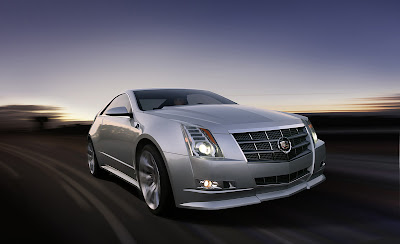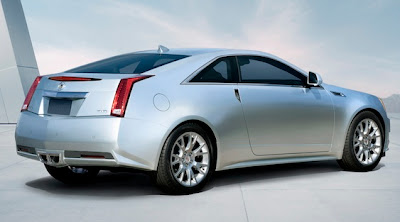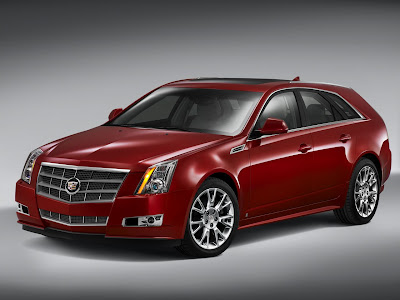Aggressive and elegant, expressive and sophisticated, the Cadillac CTS exudes a dramatic design presence. This all-new luxury sedan not only pushes Cadillac's acclaimed design theme higher, it aims to redraw the boundaries of the normally conservative luxury sedan category. Inside and out, the Cadillac CTS contradicts many traditional design conventions. CTS' design expresses its serious performance intent, yet also is more elegant and luxurious. It's a sedan in the heart of the luxury market, yet reaches for the charisma of a sports car. CTS is thoroughly new and contemporary, even while it evokes the grandeur of classic Cadillac cars.
Since the inception of the first-generation car in 2002, Cadillac CTS is about trend-setting design. The edgy form of the CTS initially created controversy. But from the moment it hit the market, its design also attracted lots of buyers, with design often noted as a top reason for purchase. The all-new 2008 edition extends that edgy and contemporary character, with an injection of elegance.
On the exterior, there's no mistaking the five-passenger sedan's stronger stance, thanks to a two-inch wider track. Additionally, the overall shape of the CTS features a faster profile with more rake, coupled with surfaces that add elegance and grace. Borrowing from Cadillac's legendary heritage, design cues include vertically shaped headlights and taillamps, signature light emitting diode (LED) exterior lighting, horizontal spline lines and its dihedral-shaped hood, all highlighted with many bright and jeweled accents.
Coupled with a new overall shape, the most evolutionary dimension of the Cadillac CTS comes in the form of a two-inch wider track as a result of the addition of the new, optional all-wheel-drive configuration. The wider stance gives the new model a more planted, capable and well-grounded appearance that's exemplified by much tighter tire-to-fender relationships.
The wider stance also enables more tumblehome - the vehicle sides are sculpted inward - delivering an appearance of rear-wheel-drive performance with a lower roof line, without compromising headroom or a roomy interior.
Additionally, a wider, tapering sail panel, lower, more sculpted hood, smoother wheel housing lips and a tighter wheel-to-body relationship help communicate the CTS' agility as well as its sophistication and substance.
The Cadillac CTS represents a new design theme for Cadillac interiors, emphasizing technical precision with elegant, hand-crafted details. Dramatically different from the original, the interior design is decidedly more upscale, with added ornamentation, luxury and attention to detail. Strict attention to packaging, premium materials, surface development and comfort combine to meet the discriminating tastes of luxury performance sedan buyers.
Upper instrument panel and door trim surfaces are hand-cut, sewn and wrapped by expert craftsmen. Analog instrumentation that is tightly framed with a compact hood tri-tubular, chromed cluster, is defined by bright accents. An integrated center stack design, with either a satin metallic finish or genuine Sapele wood, blends into the lower instrument panel that sweeps forward and away of front-seat occupants. The hand-assembled center console leads seamlessly into the center stack, providing a sportier "cockpit" feel for the driver and passenger without compromising space.
Heated and ventilated seats incorporate new "thin-seat" technology for maximum occupant comfort and enhanced rear-seat leg, knee and foot room. A signature V-shaped medallion appears as a decorative touch on the backs of the front seats. French stitching is used throughout the interior, including the upper instrument panel, door inserts, seats and the shifter boot.
Clean, white ambient light emitting diode (LED) soft backlighting is positioned in the door pulls, foot wells and recessed between the upper and lower instrument panels. The result is a dramatic effect similar to recessed lighting used in contemporary homes.
Cadillac engineers have designed and developed new geometry for both the independent short/long arm front suspension and the multilink rear suspension. Engineers implemented numerous tweaks and revisions to the suspension using extensive computer modeling, combined with development driving of prototype cars on roads all over the world, but mostly in North America, Europe and China . From famed tracks such as Germany 's Nürburgring to everyday roads in the U.S. and China, the Cadillac CTS suspension was exhaustively tested and honed.
The use of aluminum in the upper and lower front control arms and knuckles helps reduce mass and contributes to higher limits in handling and dynamic wheel control. Front suspensions for the rear-drive model and the all-wheel-drive version, while similar, have been designed to best meet the chassis dynamics of the individual versions.
The engine cradle has six attachment points, two more than typically used on a performance sedan, to better handle heavier loads and engine vibration.
Since the inception of the first-generation car in 2002, Cadillac CTS is about trend-setting design. The edgy form of the CTS initially created controversy. But from the moment it hit the market, its design also attracted lots of buyers, with design often noted as a top reason for purchase. The all-new 2008 edition extends that edgy and contemporary character, with an injection of elegance.
On the exterior, there's no mistaking the five-passenger sedan's stronger stance, thanks to a two-inch wider track. Additionally, the overall shape of the CTS features a faster profile with more rake, coupled with surfaces that add elegance and grace. Borrowing from Cadillac's legendary heritage, design cues include vertically shaped headlights and taillamps, signature light emitting diode (LED) exterior lighting, horizontal spline lines and its dihedral-shaped hood, all highlighted with many bright and jeweled accents.
Coupled with a new overall shape, the most evolutionary dimension of the Cadillac CTS comes in the form of a two-inch wider track as a result of the addition of the new, optional all-wheel-drive configuration. The wider stance gives the new model a more planted, capable and well-grounded appearance that's exemplified by much tighter tire-to-fender relationships.
The wider stance also enables more tumblehome - the vehicle sides are sculpted inward - delivering an appearance of rear-wheel-drive performance with a lower roof line, without compromising headroom or a roomy interior.
Additionally, a wider, tapering sail panel, lower, more sculpted hood, smoother wheel housing lips and a tighter wheel-to-body relationship help communicate the CTS' agility as well as its sophistication and substance.
The Cadillac CTS represents a new design theme for Cadillac interiors, emphasizing technical precision with elegant, hand-crafted details. Dramatically different from the original, the interior design is decidedly more upscale, with added ornamentation, luxury and attention to detail. Strict attention to packaging, premium materials, surface development and comfort combine to meet the discriminating tastes of luxury performance sedan buyers.
Upper instrument panel and door trim surfaces are hand-cut, sewn and wrapped by expert craftsmen. Analog instrumentation that is tightly framed with a compact hood tri-tubular, chromed cluster, is defined by bright accents. An integrated center stack design, with either a satin metallic finish or genuine Sapele wood, blends into the lower instrument panel that sweeps forward and away of front-seat occupants. The hand-assembled center console leads seamlessly into the center stack, providing a sportier "cockpit" feel for the driver and passenger without compromising space.
Heated and ventilated seats incorporate new "thin-seat" technology for maximum occupant comfort and enhanced rear-seat leg, knee and foot room. A signature V-shaped medallion appears as a decorative touch on the backs of the front seats. French stitching is used throughout the interior, including the upper instrument panel, door inserts, seats and the shifter boot.
Clean, white ambient light emitting diode (LED) soft backlighting is positioned in the door pulls, foot wells and recessed between the upper and lower instrument panels. The result is a dramatic effect similar to recessed lighting used in contemporary homes.
Cadillac engineers have designed and developed new geometry for both the independent short/long arm front suspension and the multilink rear suspension. Engineers implemented numerous tweaks and revisions to the suspension using extensive computer modeling, combined with development driving of prototype cars on roads all over the world, but mostly in North America, Europe and China . From famed tracks such as Germany 's Nürburgring to everyday roads in the U.S. and China, the Cadillac CTS suspension was exhaustively tested and honed.
The use of aluminum in the upper and lower front control arms and knuckles helps reduce mass and contributes to higher limits in handling and dynamic wheel control. Front suspensions for the rear-drive model and the all-wheel-drive version, while similar, have been designed to best meet the chassis dynamics of the individual versions.
The engine cradle has six attachment points, two more than typically used on a performance sedan, to better handle heavier loads and engine vibration.















